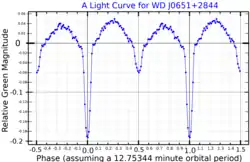WD J0651+2844
WD J0651+2844 is a white dwarf binary star system composed of two white dwarfs.[2] They are approximately 120,000 km apart and complete an orbit around their barycenter in less than 13 minutes.[1] This produces an eclipse every 6 minutes. This makes it possible to gather enough data to produce extremely accurate predictions of each future eclipse. The eclipse times deviate from the time predicted in a way consistent with gravitational waves.[3][4][5]
| Observation data Epoch J2000 Equinox J2000 | |
|---|---|
| Constellation | Gemini |
| Right ascension | 06h 51m 33.338s |
| Declination | 28° 44′ 23.37″ |
| Orbit[1] | |
| Period (P) | 12.75344 minutes |
| Inclination (i) | 84.4° |
| Details | |
| Mass | 0.26 / 0.50[1] M☉ |
| Radius | 0.0371 / 0.0142[1] R☉ |
| Temperature | 16530 / 8700[1] K |
| Other designations | |
| Database references | |
| SIMBAD | data |
References
- Hermes, J. J.; et al. (2012), "Rapid Orbital Decay in the 12.75-minute Binary White Dwarf J0651+2844", The Astrophysical Journal Letters, 757 (2): L21, arXiv:1208.5051, Bibcode:2012ApJ...757L..21H, doi:10.1088/2041-8205/757/2/L21, S2CID 119108968
- "Space-warping white dwarfs produce gravitational waves". SpaceDaily. 3 September 2012.
- "Space-warping white dwarfs produce gravitational waves". e! Science News. 28 August 2012. Retrieved 2012-09-01.
- Palmer, J. (29 August 2012). "Gravitational waves spotted from white-dwarf pair". BBC News. Retrieved 2012-09-01.
- "Einstein's space 'ripples' confirmed". United Press International. 28 August 2012. Retrieved 2012-09-01.
This article is issued from Wikipedia. The text is licensed under Creative Commons - Attribution - Sharealike. Additional terms may apply for the media files.
